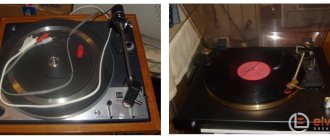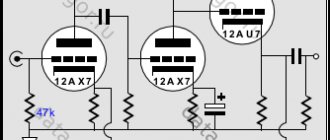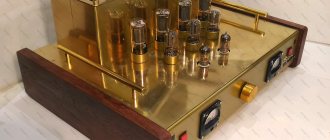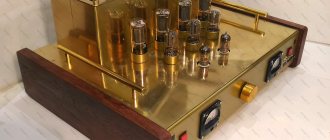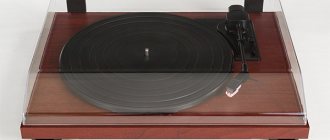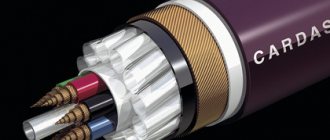Tube phono stage from the Middle Kingdom
A couple of years ago, once again going through the rubble in the attic, I came across a small box of records. As a child, I somehow didn’t pay much attention and showed no interest in the vinyl player (Vega-106), which complemented the then classic set of the Odyssey amplifier and the Olympus reel-to-reel tape recorder. And it so happened that my love for music began to appear and develop at the peak of the popularity of compact cassettes, and then came CDs, the Internet, mp3 and so on. It’s hard to say what stopped me from continuing to clean out the attic... or the unbearable heat, or a feeling of laziness... or a great sense of nostalgia, because on the records I began to find artists I loved that I had not listened to for a long time. In general, without hesitation, I took the record player and records under my arm and went home, not expecting anything fantastic from my find... I just had a pleasant feeling of nostalgia and the feeling that I had found a “family heirloom” of sorts. At home, I still did not know what kind of information flow I would face in the near future. And since the player already had a modified phono preamplifier, which my father made with his own hands using diagrams from magazines of that time... Without thinking twice, I soldered 2 RCA cables, connected them to the amplifier and started the player. Surprisingly, it was in good condition; the grease on the bushing had not even dried out. I knew absolutely nothing about the very structure of the turntable, about the needles, about the tonearm, about tracking force... nothing at all. The first records I listened to were The Doors and Creedence Clearwater Revival. And at that moment I realized that my very budget sound configuration sounded completely different. The sound was engaging, jump-starting, and simply “sausaging.” It was at that moment that a “spark of love” flashed through me and I realized that I couldn’t quit this business so easily. In the evenings I enjoyed the sound of my favorite bands and thought about buying a couple more used records.
Pitch hell began after I started studying the materiel. One point began to bother me - the dependence of the needle clamping force on the wear of the plates. First of all, I felt sorry for the records... most of them were simply in perfect condition and I would like to preserve them for as long as possible. And one fine evening I started setting up the player... and ultimately, after setting it up “according to the instructions,” I got a dry, lifeless and banal sound, not very different from flac and even mp3 played on a computer. It was precisely that moment that I still hate the most... because it became the basis for purchasing a new player, a new cartridge, a brush, scales, washing liquid and other crap that didn’t make my soul feel any warmer. I just wanted to hear again the engaging and exciting sound that was there at first. By and large, if I had the desire and straight arms... I could put my old turntable in order, buy a new stylus for it, finish the tonearm and it would continue to please me. But no... the path of a vinyl lover is never short... it all starts with a banal desire to listen to music and ends with “sex” with tonearms, heads, specks of dust on records... and this is unfortunately the reality! Everything turns into illness, obsession and sometimes sleepless nights. Thank the eggs, but I was able to stop myself and finally be happy with what I have and... start listening and enjoying the music... because in the end, this is the most important thing - to listen and experience emotions, and no matter what you do it on.
This phono preamplifier was taken as a gift to my father... who really loves listening to music and does not breathe evenly towards the “lamp”, but there is not enough time for all this “insanity”. Having looked at the prices for custom phono preamplifiers, somehow the desire has completely disappeared, not to mention branded ones... Well, but our Chinese, under the Little Bear brand, as it turned out... assembles very worthy equipment with the possibility of subsequent upgrades.
The parcel arrived in a relatively small box. To be honest, it was packed like a 4... the cat cried out of the polystyrene foam, but everything was intact. There are many reviews on specialized forums for phono stages of this brand. In short - cheap and decent, with the possibility of finishing.
Complete set: — Preamp — 1 6Z4 lamp — 2 6N2 lamps — 3 plexiglass bulbs — Network cable — Ground cable
The cables are standard, the length of the network cable is 1 meter, the length of the ground cable is 3 meters. Grounding is absolutely necessary... without it there is a constant low-frequency hum in large quantities
Plexiglas flasks. Made with high quality. Each has 3 screws for fastening to the case
Well, our handsome phono stage with the following characteristics: Output voltage: 1.5 V Gain = 48 dB Input RIAA ≤ 5 mV THD ≤ 0.5% Frequency response: standard characteristics Signal-to-noise ratio ≥ 65 dB (A) 1 kHz ( input: 10mV, output: 0.7V) Power: AC110V (115V) / 220V (235V) 60Hz / 50Hz (the correct version will be sent according to your address) Weight: 1.7kg
It is also worth adding: - Works only with MM cartridges, MC are not supported - Does not support class D amplifiers - Supports 6N2/ECC83 tubes, which can be replaced with such as 6H2,6H2n (for 6N2 mode) and 2AX7B,6N4(9PIN ),ECC83.5751 (for ECC83 mode)
There is a transformer at the back, which is protected from the lamps by a metal plate. Designed for 220V input and 6.3V output.
On the front there are gold-plated RCA connectors and a spring-loaded latch for grounding
At the top there are connectors for lamps, as well as a switch between different types of lamps
As for the lamps, unfortunately nothing special can be highlighted. These are ordinary standard lamps that are not in great demand among vinyl lovers. But I’m glad that there is room for freedom and you can install other lamps without finishing anything... this is undoubtedly a huge plus. I also want to draw your attention to the fact that the 6Z4 lamp is not involved in any way in the audio path, but is used as an anode voltage rectifier
And of course, what’s a review without internals? There will be a lot of photos, I tried to show in detail every detail for those who are interested. For those who want to go deeper, the datasheets are available online. I’ll add on my own behalf - the details are decent, correctly selected and not “turd”. Overall, excellent switching and wiring, everything was done wisely. Silicone pads are glued to the large brown capacitors to avoid contact with the metal case.
The lamps become very tight and you need to use a lot of force to install or remove them. The flasks are screwed on just as tightly, do not dangle or turn, everything fits well.
Well, now about the main thing - the sound! Over time, I came to the conclusion that all these pseudo-scientific and occult descriptions of sound, which are replete with almost all reviews, are mostly a complete pumpkin and a spanked crucian carp. The sound is either there or it’s not... you either like it or you don’t. All! At the output we should get a pleasant and balanced sound. Everything else is hype, nagging, the desire to have better and more, having read everything on the forums, etc. You need to clearly understand for yourself that you are either listening to music and enjoying it, or you are trying to catch the light buzz of a mosquito flying past the microphone and the accidental fart of the drummer while a guitar solo is playing. Of course, detailed sound is very good... but it’s even better when it’s just high-quality, involves and rocks you, in common people it’s called “rushing.” So, I liked the sound on this phono preamplifier... it’s nice to listen to, it’s attractive, and I feel the difference with my cheap transistor one. Therefore, I can confidently recommend it to everyone who wants to touch the “lamp” and who is joining the world of vinyl, but does not want to spend a lot of money on it and is aware
You can prove something to someone for a long time, explain something... give graphs, call on spirits... the main thing is that each of us receives pleasure and joy. Your ears are the most faithful “professor” in the music world... only you will understand what is pleasant and good for you, and what is not... and of course, don’t forget about your brains! They, too, should be friends with your ears... and at the right moment, tell your ears when they are starting to be bullied. And of course, tell you when you need to stop being fooled by all sorts of stories, spending crazy money in search of the very best. What am I talking about anyway? - So that disputes and condemnations do not begin, although they will happen anyway.
Well, at the end of the day, for relatively sane (or insane) money, we get a well-made device that pleases with both the build quality and sound quality... or we buy a Hi-Res player, download our favorite music on the ball and don’t look at all the sick people who need to be taken care of nothing Thank you everyone for your attention, I hope I didn’t offend anyone and don’t forget to listen to the music and not disassemble it into atoms! Happy upcoming year everyone!
↑ Design and details
The corrector itself is assembled on a printed circuit board.
See the bottom of the article for links to hardware from the project.
I was a little disappointed with the Vishay electrolytes used in the power filters.
All five copies have a capacitance 20% less than the nominal value, ESR reaches 0.5 Ohm, quality factor 0.6% - 0.8%. Often, measuring the cheapest "no-name" samples gave the best results! The capacitors in the correction circuits are composite, selected according to the capacitance values actually measured by a wonderful Chinese device.
The output separation capacitance is composite: 4 μF (MBGCh) + 0.33 μF (K40U-9) + 0.01 μF (FT-1). For power supply, I used two trances - anode (220 V/65 mA) and filament (9 V/2.5 A). I used KREN5B as a filament stabilizer.
Elements of anode power and filament filters, as well as anode voltage supply delay circuits, are mounted on printed circuit boards.
Diodes 2D213A and KREN5B are installed directly on the chassis through mica spacers and thermal paste to ensure better heat dissipation.
Case GAINTA B019BK
275×175×65mm, metal, black from “Chip-Dip”.
All assembly elements are attached to the lower base except the network cable socket, fuse holder, POWER button and LED. These elements are installed on the top cover.
Holes are drilled in the lid above the lamp cylinders and protective flanges are installed. Input and output RCA sockets are fixed to the base on the rear side of the structure.
↑ Output transformers
Rice. 38.
“Rubin 106”
“Rubin 106” produced in 1964 worked out all conceivable and inconceivable terms and became the donor of two transformers, TVZ and TVK on the same hardware Ш16×32.
Rice. 39.
Since the main distortion is introduced by the final stage, I decided to use a cathode winding in the output transformer. In the electronic simulator, an output stage was simulated with an additional cathode winding having 5% of the turns of the primary winding. The cascade gain is reduced by approximately two times, the ratio of the primary and secondary windings is 3:1. The calculation of the transformer was carried out in the online program “Online calculator of output transformers” (the resource is currently not available). During the calculation, satisfactory frequency characteristics of the transformer were obtained with a primary winding current of 20 mA, so the operating mode of the 6N6P lamp was chosen as follows: Ua = 135 V, Ia = 20 mA, Ug = -4 V, which differs from the recommended specifications for this lamp mode Ua = 120V, Ia = 30 mA, Ug = -2V.
Transformer parameters
The primary winding contains 3960 turns, the secondary winding 1386 turns and the cathode winding 198 turns.
All windings are wound with PEV-2 0.13 mm wire. Sectioning of the coil:
→ primary winding - 990 turns (5 layers of 198 turns), → secondary winding - 1386 turns (7 layers of 198 turns), → cathode winding - 198 turns, → primary winding - 1980 turns (10 layers of 198 turns ), → cathode winding -198 turns, → secondary winding - 1386 turns (7 layers of 198 turns), → primary winding - 990 turns (5 layers of 198 turns). Parts of the primary winding are connected in series, the secondary and cathode windings are connected in parallel. Non-magnetic gap 0.05mm, one layer of capacitor paper. The iron cores are divided equally between the transformers.
As a result, the output stage has the following parameters:
Rice. 40.
THD output stage
Rice.
41. Frequency response of the output stage
Rice. 42.
Internal noise of the output stage
Rice. 43.
External view of the output stage module
Rice. 44.
Output stage measurements
↑ Background
The experience gained in the manufacture of my first phono stage was useful in the work. Tube preamplifier RIAA-phono stage.
First experience. The topic is the same - making a phono stage for your loved one. The birth of the brainchild was somehow difficult and took a very long time; the work on making a new corrector stretched out over time, flaring up and then dying out under the weight of everyday worries. Several times I stopped doing it altogether, pushing it into the far corner for a month, two, three and devoting myself to more important and urgent matters. Finally, the proofreader was completed and put into operation.
The reason for the manufacture of a new phono stage was the search for a circuit diagram of a Chinese clone of the Marantz 7 phono stage. Unlike the original, all stages of the clone were made on a 12AX7 lamp.
Rice.
1. Marantz 7 diagram
Rice. 2.
Scheme of the Chinese clone Marantz 7
RIAA correction is carried out in a frequency-dependent general feedback loop. Somewhere on the forum I came across that such circuits give a “rotten” sound. I cannot say categorically either. Personally, I didn’t like the following: strange male vocals, unnatural drums, no attack, no real punch, and the sound is inexpressive, it doesn’t take away. It seems to be playing, but somehow without a soul.
Rice. 3.
THD in percent
Rice.
4. Anti-RIAA
Rice. 5.
Dependence of THD on signal level
Rice. 6.
Clone's own noise
Rice. 7.
Noises by octaves
I don’t know what load this corrector is designed for. The capacity of the output coupling capacitor (in the device is 1 uF, although according to the circuit it is 2 uF) is not enough to work with an audio card with an input impedance of 20 kOm. The low-frequency rollover is equal to -3 dB already at a frequency of 60 Hz and -5 dB at a frequency of 20 Hz. Corrector lamps V1b and V2a operate in anode microcurrent mode. The coefficient of nonlinear distortion at low signal levels reaches 4%.
↑ Transistor selection
Lecture No. 13. “Current sources on bipolar and field-effect transistors. Stabilizers."
“...In the circuit of a current source on a bipolar transistor, the latter must operate in the active mode, and its operating point will lie on a flat section of the current-voltage characteristic; the constructed load characteristic at the intersection with the static current-voltage characteristic should ensure the position of the RT on a flat section (DE)..."
Rice. 18.
It is clear that two volts is not enough for the transistor to operate at least in the initial section of the linear part of its current-voltage characteristic. Most likely, you need low-power transistors designed to amplify weak signals, with a low collector-to-emitter voltage drop and high gain. First I turned my attention to germanium transistors of the P401-402 series. But only transistors from older releases were available, which, according to their data sheet, have a maximum emitter current of 10 mA, and the measured gain turned out to be no more than 110. As a result of searches, tests and measurements, I settled on the next pair of candidates. These are a high-frequency low-power germanium transistor P416B and a silicon transistor for amplifying small signals STS1980. For the P416B, a spread of β is provided from 90 to 250, for the STS1980N from 120 to 240. It is advisable to select transistors with the maximum gain, because we count every “parrot”.
Morgan Jones “Tube Amplifiers” DMK Moscow 2007, p. 240
“...The equivalent resistance of the lamp on the anode side is defined as the product of Rk by β, that is, the lamp, as it were, multiplies Rk by β.
Likewise, a bipolar transistor multiplies any resistance in the emitter circuit by β or h21. Thus, the output characteristics of the transistor can be equalized by adding a resistor to the emitter circuit. Since h21 of a low-power transistor is approximately ~400, a 100 Ohm resistor in the emitter circuit gives an output resistance of ~40 kOm. The cathode follower multiplies this resistance by its β, for example 20. As a result, we obtain Rн ~8 MOm (the author was “ slightly
” mistaken, 40,000 × 20 = 800,000 kOm), which is even better than what can be achieved in a conventional β-follower. A β-follower can easily provide an equivalent output impedance of Rн>50Ra, even with a low β of the upper lamp..."
Operating mode of transistor P416B:
R5 = 75 Om, R6 = 18 kOm, Uce ~ 1.25 V, I = 10 mA.
Rice. 19.
P416B
The module parameters and sound are decent, the transistor can be used. There is one drawback, this is a large spread in the parameters of the transistors. You need a pair with similar parameters with a maximum gain; perhaps, several dozen transistors will be needed for selection. Of the 16 P416B pieces available, one had β=195, the closest ones had β=150 and 145, the rest had β from 88 to 115. The measurements were carried out with transistors that had β=195 and β=150.
Rice. 20.
THD with transistor P416B with β=195 in percent
Rice.
21. THD with transistor P416B with β=195 depending on the signal frequency
Rice. 22.
THD with transistor P416B with β=195 depending on the signal level
Rice. 23.
Internal noise of the module with transistor P416B with β=195
When trying to use a transistor with β=150, the total harmonic distortion increased uncritically from 0.012% to 0.015%, but the harmonic spectrum changed and the module’s own noise increased slightly (by 3 dB). The parameters also changed for the worse at low signal levels; at -40 dB, THD more than doubled. The increase in the second harmonic was insignificant, but the higher harmonics grew faster, which is not very good.
Rice. 24.
THD with transistor P416B with β=150 in percent
Rice.
25. THD with transistor P416B with β=150 depending on the signal level
Rice. 26.
Internal noise of the module with transistor P416B with β=150
Operating mode of the STS1980 transistor:
R5 = 75 Om, R6 = 9.1 kOm, Uce ~ 1.25 V, I = 10 mA.
Rice. 27.
STS1980
Of the four pieces, two transistors turned out to be with β=225. The parameters of the cascade are practically no different from the cascade with a germanium transistor P416B with β = 195. During the measurements, the same module and power supply were used, only the transistor current source was replaced. The values of multiple measurements turned out to be very close, both in terms of distortion and noise. It is clear that during the measurements there was a certain scatter of parameters; average values are given.
Next, I recorded several tracks using different transistors in the current source and recorded an audio CD with pairs of identical tracks. When listening, I did not hear any differences; everything played smoothly, naturally and pleasantly. A big plus is the presence of a pair of transistors with similar parameters and high β. In general, I settled on STS1980.
Rice. 28.
THD with transistor STS1980 in percent
Fig.
29. THD with transistor STS1980 depending on signal frequency
Rice. thirty.
THD with STS1980 transistor depending on signal level
Rice. 31.
Internal noise of the module with transistor STS1980
Preface
Many times I thought about a tube amplifier, but the prices for branded devices from the segment of interest, easily exceeding a million, were far from my budget. There was an option to try the author’s products, and I had an attitude towards them that was not so much dismissive, but wary. But it so happened that, while at the next audition, I was very impressed by the sound of the author's tube amplifier using 300V tubes. True, it was connected to speakers with wideband speakers, the sound features of which do not quite suit me. And when I found out that the author of the amplifier is our fellow countryman, a guru of lamp construction, from whom you can order an amplifier to suit your requirements, I was finally convinced that I needed to use this chance.
Looking ahead, I will say that I have never regretted that I got involved in this adventure and was pleased with the result. It’s not very nice to “praise your cabbage,” so I’ll try to keep the story as restrained as possible. I hope that my experience will be interesting to you.
Music
I won’t use enthusiastic epithets and audiophile terms. I will only write that I received exactly what I expected. The sound is conducive to relaxing listening, with a gorgeous stereo stage where every instrument can be heard. That is the case when you no longer want to analyze anything. At the same time, on some recordings the sound is so focused that it sometimes seemed to me that the vocalist was singing from the center channel speaker from the cultural center. One time, I couldn’t even stand it and took it off the rack.
It is known that for a deep stereo scene, the speakers need to be moved at least a meter from the back wall. Unfortunately, it is not possible for most users to arrange the acoustics in this way, including me. But I conducted an experiment, placed the speakers along a short wall of the room, which made it possible to move them further away from the wall, and this gave a stunning result. For example, on the well-known Visaton test disc, track No. 15, where drums and trumpets sound, you get the feeling that the drums are 20 meters away from you, or even further.
A little “warm tube sound”. Yes, usually the sound of tube amplifiers has a softened presentation. For some this will be a plus, like for me, for others it will be a minus, for example, for fans of modern furious music. Although, I specifically downloaded and listened to the Billie Eilish album “When We All Fall Asleep, Where Do We Go?” and (abstracting from the material itself) I didn’t hear any lack of dynamics, especially in ultra-linear mode.
Those who are now 40+ probably listened to tube radio in childhood and absorbed its sound on a subconscious level, so the sound of tube amplifiers can be associated with something familiar and cozy. But all the same, perception is a purely individual thing. Therefore, I see no point in developing this topic.
↑ New background corrector
Nevertheless, searching, thinking, reading material, and so on began.
Since the circuit had attractive aspects - direct connection of the cascades, the absence of electrolytic capacitors in the cathode circuit, the capacitors of the correction circuit are under polarizing voltage, accessible parts, I still decided to find an acceptable solution for myself. I simulated the options in an electronic simulator; I really wanted to preserve the direct connection of the cascades. As a result, I settled on the following circuit: the first stage is a beta follower on a pnp transistor with LED bias, the second stage with cathode coupling remains unchanged.
Rice. 15.
Phono stage circuit.
↑ Sound
I’m not used to describing the sound with all sorts of epithets, I’ll just say that compared to the K548UN1, the sound has become more dynamic, this is especially felt when listening to instrumental and classical music. The frequency range from below has definitely expanded.
Master
Without delaying the matter, I called this master, made an appointment, loaded my speakers into the car and went to his country house. Ironically, I had been watching this man for 20 years at the local radio market, but, unfortunately, I did not know him personally.
In short, I was given an educational program on tube amplifiers, which I only understood in general terms. Specifically about my situation (three-way speakers with low sensitivity), it was said that the situation is difficult, but solvable. A suitable amplifier with powerful tubes (KT-150) just happened to be available, but the customer had not yet picked it up. I promised to speak with restraint, so I won’t describe my culture shock in detail. Let me just say that this was exactly what I was looking for. But what pleased me most was the master himself, a very sincere person for whom audio technology is in no way a business, but a matter of his whole life. Since there was no talk of any exorbitant prices, we quickly agreed. I immediately ordered the same amplifier, and at the same time a tube phono stage, because... I also have a vinyl player in my system. The only thing is that I was not satisfied with the appearance of the devices. So I decided to make custom cases.
